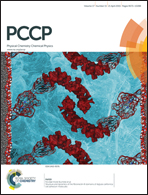Gluing together metallic and covalent layers to form Ru2C under ambient conditions
Abstract
Ru2C has recently been synthesised at high pressure and high temperature, and was assumed to have a structure with space group P![[3 with combining macron]](https://www.rsc.org/images/entities/char_0033_0304.gif) m1. However, subsequent theoretical work has revealed that this structure is unstable under ambient conditions, which motivated us to look for the stable structure. In this work, we explore the structures of Ru2C by using an unbiased swarm structure searching algorithm. The structures with R3m and R
m1. However, subsequent theoretical work has revealed that this structure is unstable under ambient conditions, which motivated us to look for the stable structure. In this work, we explore the structures of Ru2C by using an unbiased swarm structure searching algorithm. The structures with R3m and R![[3 with combining macron]](https://www.rsc.org/images/entities/char_0033_0304.gif) m symmetries have been found to be lower in energy than the P
m symmetries have been found to be lower in energy than the P![[3 with combining macron]](https://www.rsc.org/images/entities/char_0033_0304.gif) m1 structure, at the same time being dynamically stable under ambient conditions. These layered structures consist of alternating Ru bilayers and C monolayers in the R3m structure, and alternating Ru tetra-layers and C bilayers in the R
m1 structure, at the same time being dynamically stable under ambient conditions. These layered structures consist of alternating Ru bilayers and C monolayers in the R3m structure, and alternating Ru tetra-layers and C bilayers in the R![[3 with combining macron]](https://www.rsc.org/images/entities/char_0033_0304.gif) m structure. The C layers are more evenly distributed and more covalently bound to the Ru layers in the R3m structure than in the R
m structure. The C layers are more evenly distributed and more covalently bound to the Ru layers in the R3m structure than in the R![[3 with combining macron]](https://www.rsc.org/images/entities/char_0033_0304.gif) m structure. Instead, in the R
m structure. Instead, in the R![[3 with combining macron]](https://www.rsc.org/images/entities/char_0033_0304.gif) m structure there exists more Ru–Ru metallic bonding, which has a crucial role in diminishing the hardness of this material. Our findings should stimulate further explorations of the structures and properties of the heavy transition metal carbides and nitrides, potentially leading to industrial applications.
m structure there exists more Ru–Ru metallic bonding, which has a crucial role in diminishing the hardness of this material. Our findings should stimulate further explorations of the structures and properties of the heavy transition metal carbides and nitrides, potentially leading to industrial applications.


 Please wait while we load your content...
Please wait while we load your content...